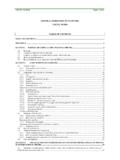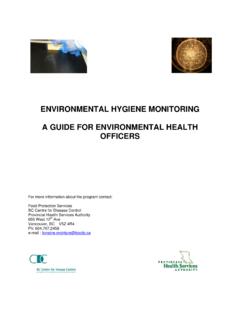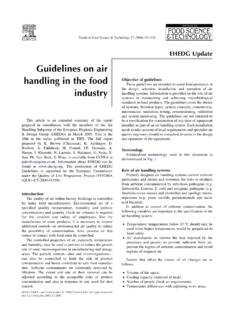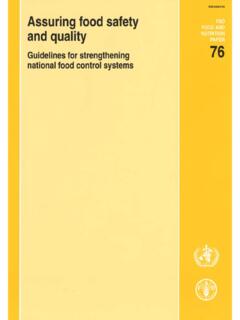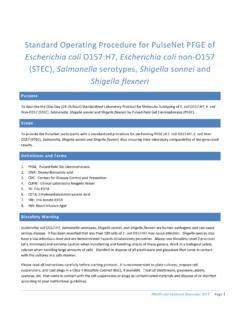Transcription of Laboratory Processing of Fecal Specimens
1 APPENDIX 10. Laboratory Processing of Fecal Specimens T. his Laboratory manual includes three pathogens that may be isolated from Fecal Specimens : Shigella, Vibrio cholerae O1/O139, and Salmonella serotype Typhi. Methods for the Laboratory detection of other enteric pathogens can be found in other manuals, such as the American Society for Clinical Microbiology's Manual of Clinical Microbiology or the World Health Organization's Manual for the Laboratory Investigations of Acute Enteric Infections. The methods presented in this manual are intended to be economical and to offer laboratorians some flexibility in choice of protocol and media. Laboratories that do not have sufficient resources to adopt the methods described in this chapter should consider sending Specimens or isolates to other Laboratory facilities that routinely perform these procedures.
2 Enteric pathogens of public health concern cause both diarrheal disease and fever of unknown origin. Only a few pathogens cause epidemic diarrhea, although many cause sporadic diarrhea. S. dysenteriae serotype 1 and V. cholerae are the two etiologic agents responsible for most epidemic diarrhea in the developing world, contributing substantially to the burden of morbidity and mortality. S. Typhi, the etiologic agent of typhoid fever, is responsible for a substantial portion of the burden of fever of unknown origin. In countries at risk for epidemics of dysentery or cholera, the Laboratory 's first role is to be prepared for an epidemic; this means having ready access to the supplies necessary to identify V. cholerae O1/O139 and Shigella. Appendix 9 lists Laboratory supplies required for isolation, identification, and antimicrobial susceptibility testing, as appropriate for district-level laboratories, regional laboratories, and national reference laboratories.
3 All countries should have at least one national or central Laboratory capable of identifying Shigella and V. cholerae O1/O139, determining antimicrobial susceptibility, and sending isolates to a regional or international reference Laboratory ; Appendix 12 includes international shipping regulations and Appendix 14 lists international reference Laboratory contact information. Collection, storage, and transport of stool Specimens are addressed in Appendix 9. Methods for isolation of S. Typhi, V. cholerae, and Shigella from stool Specimens are detailed in this appendix, whereas each of the pathogen-specific chapters address pathogen identification and antimicrobial susceptibility testing methods, including guidelines for interpretation of results to help shape patient treatment and policy. Laboratory Processing of Fecal Specimens | 287.
4 Serogrouping and typing methodologies are included and these procedures are encouraged, when resource levels at the Laboratory permit. (S. Typhi is included in Chapter VII; Shigella is included in Chapter VIII; and, V. cholerae is included in Chapter IX.). Determination of antimicrobial susceptibility patterns not only helps shape successful treatment plans for individual patients but also assists with the development of public health policy for populations at risk for exposure. As mentioned in the introduction to this Laboratory manual, because antimicrobial susceptibility testing is so resource intensive and requires a consistent investment in Laboratory infrastructure and quality control, the World Health Organization (WHO) recommends that antimicrobial susceptibility testing occur at only one or two laboratories in a country with limited resources.
5 Antimicrobial susceptibilities should be determined for the first 30 to 50 isolates identified by the Laboratory at the beginning of an epidemic. Peripheral laboratories may perform initial isolation of Salmonella (including serotype Typhi), Vibrio, and Shigella isolates, and then refer isolates to the central or national reference Laboratory for final confirmation and determination of antimicrobial susceptibility. Peripheral laboratories may also be the sites of focused studies to determine etiologic agents causing an outbreak. First-level laboratories should be supplied with transport medium and the means of sending the Specimens to the next level Laboratory or to the central Laboratory . Fecal Specimens in the Laboratory Once Specimens have arrived at the Laboratory , laboratorians should follow procedures to isolate the suspected etiologic agent.
6 In an outbreak situation, usually either dysentery or cholera is suspected on the basis of reports from health personnel in the field, and the Laboratory response should reflect this. It should be noted that although some health-care providers believe that diarrheal illnesses can be diagnosed by the appearance of the stool and, for example, diagnose dysentery if the stool is bloody and cholera if the stool is watery, this bloody versus watery distinction is by no means definitive. Diarrhea caused by Shigella, for example, is only bloody approximately 50% of the time, and there are many agents that lead to watery diarrhea. Still, clinical observations may help guide Laboratory testing. Laboratories may also receive Fecal ( , stool) Specimens from patients who are suspected to have typhoid fever. Fecal cultures may be positive during the first week of fever and may be positive 2 3 weeks into the disease.
7 (Because S. Typhi is more commonly suspected in cases of febrile illness and isolated from blood, urine, or bone marrow, pertinent isolation techniques are also included in Appendix 4, Isolation of Agents from Normally Sterile Sites. ). 288 | Manual for Identification and Antimicrobial Susceptibility Testing Recovery of S. Typhi from Fecal Specimens Maximal recovery of Salmonella ser. Typhi from Fecal Specimens is obtained by using an enrichment broth although isolation from acutely ill persons may be possible by direct plating. Enrichment broths for Salmonella are usually highly selective and will inhibit certain serotypes of Salmonella (particularly S. Typhi). The selective enrichment medium most widely used to isolate S. Typhi from Fecal Specimens is selenite broth (SEL). Selenite broth should be incubated for 14 16.
8 Hours at 35 37 C and then streaked to selective agar ( , bismuth sulfite [BS] or desoxycholate citrate agar [DCA]). A nonselective broth ( , Gram negative [GN]. broth) may also be used for enrichment for S. Typhi. Plating media Fecal Specimens to be examined for S. Typhi may be inoculated onto standard enteric plating media ( , Hektoen enteric agar [HE], xylose lysine desoxycholate agar [XLD], DCA, MacConkey agar [MAC], or Salmonella-Shigella [SS] agar). However, bismuth sulfite agar (BS) is the preferred medium for isolation of S. Typhi and should be used if resources permit. BS plates must be freshly prepared (Appendix 2) and used within 36 hours for isolation of S. Typhi. A rectal swab or stool swab may be used to inoculate BS agar by seeding an area approximately 1 inch in diameter on the agar, after which the plate is streaked for isolation.
9 After seeding the plate, the swab may be placed in a tube of selenite broth if enrichment is desired. If culturing Fecal Specimens from suspected typhoid carriers, the use of a BS pour plate may enhance isolation. For pour plates, the BS agar must be boiled and cooled to 50 C in a water bath. A 5-ml quantity of Fecal suspension is added to a Petri plate, after which approximately 20 ml of cooled BS is immediately poured into the plate. The plate is swirled to mix the Fecal suspension and the BS agar and the plate is left to harden. BS streak and BS pour plates should be incubated for 48 hours at 35 37 C. On a BS streak plate, well-isolated colonies of S. Typhi appear black surrounded by a black or brownish-black zone with a metallic sheen. On a BS pour plate, well- isolated subsurface colonies are black and circular.
10 Table 34 provides descriptions of S. Typhi colonies on other types of selective media. When colonies of S. Typhi are numerous and crowded, S. Typhi frequently does not produce typical blackening of BS; therefore, plates must be streaked carefully to permit growth of discrete colonies. When using pour plates, a second plate with a inoculum may also be prepared to insure that isolated colonies will develop. Figure 83. illustrates the appearance of S. Typhi colonies on BS agar medium. A flowchart for the isolation and identification of S. Typhi is included in Figure 29. Isolated colonies from BS or other selective media may be inoculated to Kligler iron agar (KIA) or triple sugar iron agar (TSI) or other screening media. Laboratory Processing of Fecal Specimens | 289. FIGURE 83: Salmonella colonies on bismuth sulfite (BS) agar Sub-surface colonies from BS pour plates must be re-streaked for isolation on a medium such as MAC before being inoculated into KIA or TSI.










